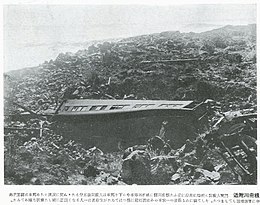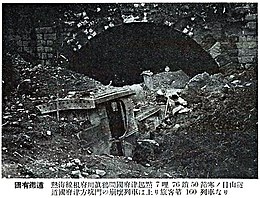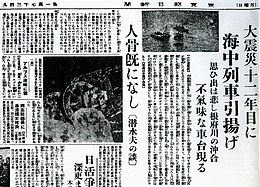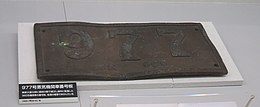Nebukawa Railway Accident
The railway accident in Nebukawa ( Japanese. 根 府 川 駅 転 転 落 事故 , Nebukawa-eki ressha tenraku jiko , dt. "Train crash at Nebukawa station") on September 1, 1923 was the result of a landslide triggered by the Great Kanto earthquake . He destroyed during and at the railway station Nebukawa, Japan , on the Atami Line (now part of the Tōkaidō Main Line ) two trains . 112 people died and 13 others were injured.
Starting position
The Tōkaidō main line ran from the Meiji period until 1934 (opening of the Tanna tunnel ) from Kōzu station north of the Hakone mountain range past the Numazu station (today's Gotemba line ). The section leading to Nebukawa Station today was still called the Atami Line at that time. It was extended to Manazuru Station on December 21, 1922 .
Train No. 109, which later crashed, consisted of the 960 steam locomotive (JNR class 5300) and eight passenger cars with bogies . He left Tokyo Station at 9:05 a.m. in the direction of Manazuru. 10:15 he reached the Ofuna station , where he obtained a fast train in the direction of Tokyo tick left and continued its journey at 10:27 pm after Odawara continued. The route of the Atami Line ran through Hayakawa Station , along a steep rock face on Sagami Bay .
the accident
Train 109
When the train was one-third into Nebukawa Station, a violent earthquake shook the area. The engine driver and conductor pressed the emergency brake , the train derailed . The main quake was followed about four minutes later by an aftershock measuring 7.3 on the Richter scale . A landslide broke off the mountain wall ( debris flow ). The fact that the Shiraito River flows past the south side of the station favored the creation of the debris flow. There are various assumptions about the origin of the landslide. One of them is that it broke away from an old crater rim on Mount Hijiri ( 聖 岳 , Hijiri-dake ) at an altitude of 837 m. Investigated soil samples also suggest the crater on Mount Ōbora ( 大 洞山 , ~ yama ), four kilometers on the upper reaches of the Shiraito, as a starting point. The landslide moved at a speed of about 50 km / h and tore the train, the platform , two water towers and the station building over a 45 m long headland down into the sea. The process is said to have taken about five minutes. Almost the entire Nebukawa station, including the arriving train, drowned in Sagami Bay. Only two cars were still on the slope and the roof of the station master's house was floating on the surface of the water.
Move 116
Train 116, headed for Tokyo, should have crossed train 109 at Nebukawa station. He was one minute late on the day of the accident. He had to cross four tunnels between Manazuru Station, which he left at 11:48 a.m., and Nebukawa Station . The earthquake occurred as the train was exiting the last of the four tunnels, the 360 m long Sainome Tunnel ( 寒 ノ 目 山 ト ン ネ ル ). The locomotive was buried under the mudslide, two railway employees died and three passengers were injured. A surviving railroad worker tried to lead the passengers back to Manazuru and out of the tunnel when a second scree avalanche broke up and carried away the four railway workers and several passengers. The bodies of the four employees and two passengers were only found a year after the accident. The Ministry of Railways recognized the actions of its railroad employees by giving one employee 100 yen and two other employees 70 yen each. Because train 116 was slightly delayed, it largely avoided the disaster that hit train 109.
Further damage
The debris stream that poured three meters high and carried by the Shiraito River over the area of Nebukawa, rolled over the houses on the estuary delta, killing more than 200 other people. The quake, the epicenter of which was in the Nebukawa region, also triggered a tsunami that reached Sagami Bay about five minutes after the quake, killing at least 20 children swimming there.
Furthermore, a reinforced concrete bridge spanning the Shiraito, the pillars of which reached a total height of 22 m including the foundation, including pillars and abutments, was torn away so that it could not be found. The river delta of the Shiraito, which was then used as an anchorage and berth for ships, silted up due to the debris avalanche and its condition was changed so much that a pine forest was created there.
The Kantō earthquake not only led to railway accidents on the Atami line. On the entire Tōkaidō line, eight passenger and 17 freight trains derailed, and many other trains caught fire, were damaged or destroyed: 46 locomotives, 424 passenger cars, 40 tram cars and 923 freight cars . Another 60 locomotives, 62 passenger cars and 281 freight cars were damaged.
consequences
Loss and damage
112 people died in the railway disaster at Nebukawa station (which includes the missing), including seven railway workers. 13 others were injured. The conductor and the train driver suffered bruises and were seriously injured by driftwood. A trainee conductor died in the crash and a trainee engine driver was swept away by the debris avalanche, as were 20 people, passengers and station staff who had been in the station.
The station master, who was not on duty that day, and his wife, who were together in the official apartment, were saved. Also rescued were 30 people who had survived the crash and climbed the slope after the accident, and a further 13 people who were rescued from passing boats.
The five injured railway employees and some surviving passengers left for Odawara at around 4:00 p.m. on the same day to give news of the accident. Since the road and railroad had been torn away over a distance of 4.4 km, it took about two hours to cover the two and a half kilometers to Ishibashi (today: western Odawara).
Commemoration
In 1932, Okano Kitarō (1864-1965) set up a memorial stone in Manazuru to commemorate the railway accident . The date of the unlucky day is engraved on the back. Kitarō, founder of the local Suruga bank, lost his third daughter and wife in the railway accident. A memorial stone was also erected for the railway in 1973 in Nebukawa station. The stone bears the inscription: " Memorial stone to the suffering caused by the Great Kantō earthquake / September 1st Shōwa 40 for all employees of Nebukawa station "
In 1932, the Ministry of Railways gave up ownership of the locomotive of train 109, which had sunk in the sea. A year later in August 1933, the Yomiuri Shimbun newspaper first published photographs of the sunken locomotive. On September 23, 1934, eleven years after the accident, the locomotive was salvaged from the sea at the instigation of a businessman from Manazuru. They also hid human bones. The businessman donated part of the locomotive, including a locomotive sign, to the Ministry of Railways, but had the larger part disposed of as scrap. After the recovered number plate was first exhibited in the Tokyo Transport Museum ( 交通 博物館 , Kōtsū hakubutsukan ), it can now be seen in the Saitama Railway Museum.
Remarks
- ↑ In Kataura ( incorporated into Odawara since 1954 ), Kanagawa Prefecture .
- ↑ Original: 「関 東 大 震災 殉難 碑」 「昭和 四十 八年 九月 一日 根 府 川 駅 職員 一同」
Individual evidence
- ↑ a b c d Masayuki Takemura: 関 東 大 震災 に お け る 米 神 ・ 根 府 川 (神奈川 県 足 柄 下 郡 片 浦村) の 被害 総 数 .
- ↑ 神奈川 県 内 の 鉄 道 記念 碑 . Retrieved December 25, 2012 (Japanese).
literature
- 武 村 雅 之 (Takemura Masayuki): 関 東 大 震災 に お け る 米 神 ・ 根 府 川 (神奈川 県 足 柄 下 郡 片 浦村) の 被害 総 数 . In: 歴 史 地震 . tape 5th , 2010 (Japanese, PDF [accessed December 25, 2012]).
Web links
- 東 日本 大 震災 の 記録 (日本 鉄 道 旅行 地 図 帳) . Shinchosha Homepage,accessed December 25, 2012(Japanese, with numerous historical images).
- 過去 の 災害 に 学 ぶ (第 13 回) 1923 (大 正 12) 年 関 東 大 震災 - 揺 れ と 津 波 に よ る 被害 . In:No. 39.2007, archived from the original onJanuary 20, 2013; Retrieved December 25, 2012(Japanese).
- 機関 車 の 残骸 . Odawara City,accessed December 25, 2012(Japanese).
- 関 東 大 地震 震害 調査 報告 . 土木 図 書館 所 蔵,Retrieved December 25, 2012(Japanese).
Coordinates: 35 ° 12 ′ 11.2 ″ N , 139 ° 8 ′ 29.1 ″ E




